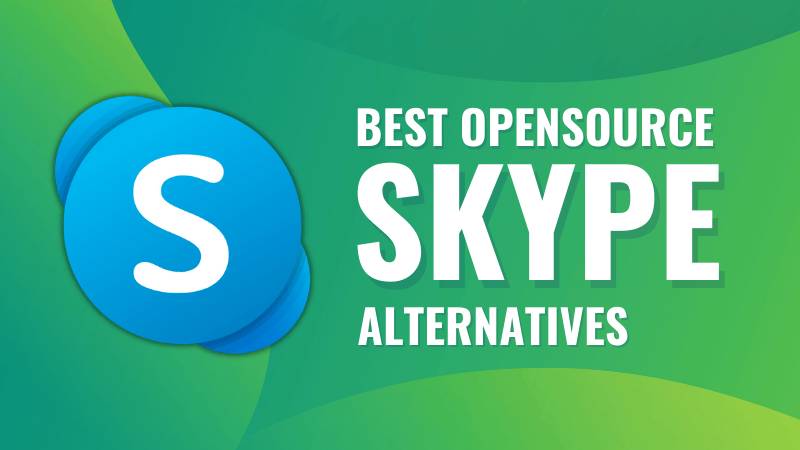On May 5th, Skype officially ends. Microsoft plans to retire it in favor of the free Microsoft Teams. Skype has left behind a unique legacy. It were able to freely interact with people all around the world because it was one of the first platforms to embrace global communications. Regardless of whether you own a low-cost gadget or a promising Samsung flagship, Skype is still regarded as a great and easily accessible telecommunications platform, despite its recent decline in popularity. The top Skype alternatives that are superior to Microsoft Teams are highlighted in our list.
FaceTime deserves special recognition
FaceTime is a good alternative to Skype for video calls if you are a major Apple customer. FaceTime is easy to set up and offers great video and audio calling quality. It is not possible to propose FaceTime as a full substitute because of its limitations, primarily related to platform availability, and the need for a workaround when attempting to set up FaceTime calls on PCs and Android devices. Still, if you already own an iPad or iPhone, it’s worth checking out FaceTime.
1. Line: A Leading Messaging Platform in Japan and Thailand
Line is one of the most popular messaging apps in East Asia, particularly in Japan and Thailand, where it plays a central role in digital communication. Designed as both a social network and a messaging tool, Line blurs the line between a texting platform and a comprehensive social experience.
As someone who has used Line over the years to stay in touch with friends across East Asia, I’ve found it reliable and user-friendly, especially for voice and video calls — both of which are free, much like what you’d expect from services like Skype. While Line may not offer the most advanced features compared to some Western apps, it stands out with its focus on personalization.
Users can customize their experience with a wide range of themes, emoji packs, and stickers available through the Line Store, making everyday chats more expressive and engaging.
Another key update worth noting is that, as of 2023, Line no longer requires a phone number to create an account. Users can now sign up using their Google or Apple ID — a significant shift, particularly in light of varying international data privacy standards.
While it may not be as globally dominant as WhatsApp or Messenger, Line holds a strong presence in the regions it serves — and remains one of the best platforms for connecting with friends and communities in Japan and beyond.
6. Telegram: A Versatile Cross-Platform Messaging App
Telegram continues to be one of the most flexible and lightweight messaging platforms available today. Designed for seamless use across devices, it supports everything from group chats and file sharing to voice and video calls — much like what users expect from apps such as Skype.
Despite some controversy surrounding its leadership in the past year — including the widely reported arrest involving Telegram’s CEO — the platform remains widely used and trusted by millions. While those events raised questions for some users, Telegram’s core appeal lies in its blend of performance, convenience, and customization.
Telegram emphasizes user privacy and offers a range of security settings, though it’s important to note that many of these features — like end-to-end encryption via Secret Chats — need to be manually enabled. Messages in regular chats are cloud-based and accessible from any device.
Account creation still requires a phone number, but users are not limited to SIM cards and can register using virtual numbers from trusted providers, offering added flexibility.
Despite its challenges, Telegram continues to be a popular option for users seeking a fast, secure, and highly functional messaging experience across platforms.
5. Google Voice: A Reliable Virtual Number and VoIP Solution
For users seeking a trustworthy virtual number service, Google Voice remains a solid choice — particularly for those within the U.S. and Canada. Similar to how many once relied on Skype for internet-based calling, Google Voice provides a convenient and cost-effective alternative for both personal and business use.
The platform offers free domestic calling within the U.S. and Canada, while international calls are available at competitive rates. It also includes essential features such as voicemail transcription, call forwarding, and robust spam filtering — all seamlessly integrated with other Google services like Gmail and Google Calendar.
With its clean interface and dependable performance, Google Voice is an excellent option for users in need of a virtual phone number or a reliable VoIP solution. Whether you’re managing remote work communications or simply looking for a streamlined calling tool, it’s worth exploring what Google Voice has to offer.
4. Discord: A Feature-Rich Platform for Community-Centered Communication
While Discord was initially popularized among gaming communities, it has evolved into a comprehensive communication platform — and a capable modern alternative to legacy services like Skype. With support for voice and video calls, direct messaging, screen sharing, and private or public servers, Discord offers far more flexibility and functionality than its predecessors.
The platform’s structure is designed around communities, or “servers,” which can be customized for anything from casual conversations to professional collaboration. This community-first approach makes it particularly appealing for users who want more than just one-on-one communication.
However, Discord may feel somewhat overwhelming to newcomers due to its robust feature set and interface complexity. Those looking for a lightweight or minimalist communication tool may find simpler apps more suitable.
Despite this, Discord’s versatility and zero-cost model make it an attractive option for users who value rich interaction, customizable settings, and long-term connectivity with specific groups. Its optional Discord Nitro subscription enhances the experience but isn’t required to access the platform’s core features.
3. Zoom: A Leading Platform for Seamless Video Collaboration
Zoom has become a go-to solution for video conferencing, especially for users seeking a reliable alternative to Skype for professional meetings, virtual interviews, or team collaboration. While Google Meet and Microsoft Teams offer excellent integration within their respective ecosystems, Zoom remains a standout for its ease of use, versatility, and robust performance.
Setting up meetings on Zoom is straightforward — simply create a room, share the invite link, and connect. The platform supports everything from one-on-one calls to large-scale conferences, making it well-suited for businesses, educational institutions, and remote teams.
Zoom also continues to innovate, incorporating advanced features like AI-powered tools to enhance meeting efficiency and productivity. Audio and video quality remain consistently high, contributing to a smooth user experience across devices.
However, it’s worth noting that Zoom’s free plan limits group meetings to 40 minutes. For longer sessions and access to premium features, upgrading to a paid plan is often necessary.
Overall, Zoom offers a professional, dependable communication experience — making it a worthy successor to Skype for users who prioritize quality and scalability in their virtual interactions.
2. Signal: A Leading Platform for Private and Secure Communication
For individuals and professionals prioritizing privacy, Signal stands out as one of the most secure messaging platforms available. As an open-source application, Signal employs end-to-end encryption by default — ensuring that only the sender and recipient can access the content of messages, calls, and media shared within the app.
Unlike many other messaging platforms, Signal is designed to minimize data collection. It does not store metadata such as usernames, profile photos, or group affiliations, and it deliberately avoids tracking user behavior. This commitment to user privacy has earned Signal the trust of journalists, activists, and security-conscious individuals worldwide.
While Signal’s user base — estimated at 40 to 70 million monthly users — is smaller compared to mainstream platforms, it continues to grow steadily due to its transparent operations and strong encryption protocols. Additionally, Signal remains completely ad-free and is funded by donations through a non-profit model, further distancing itself from data-driven business practices.
With its strong emphasis on security, ethical data policies, and user-friendly interface, Signal remains a top-tier choice for those seeking a reliable and private messaging experience.
1. WhatsApp Messenger: A Trusted Platform for Seamless Communication
WhatsApp Messenger has evolved well beyond its origins as a basic messaging app. With the addition of voice and video calling, it now serves as a dependable alternative to legacy platforms like Skype — particularly for personal and small-group communications.
One of WhatsApp’s biggest strengths is its simplicity. With a quick setup process and intuitive interface, users can start messaging, calling, and video conferencing without much of a learning curve. The app supports one-on-one or group calls with up to 32 participants, making it suitable for both casual and semi-professional use.
End-to-end encryption is enabled by default across all conversations, providing users with a secure messaging environment. While WhatsApp does require an active phone number to register — a potential limitation for some — its widespread adoption makes it highly accessible for users whose contacts are already on the platform.
WhatsApp also integrates well with desktop platforms through WhatsApp Web and the desktop app, ensuring continuity across devices. For users looking for a familiar, free, and secure communication tool with global reach, WhatsApp remains a practical and reliable choice.
Saying Skype goodbye for good
Teams (free) is Microsoft’s de facto replace, but you don’t have to use it. Depending on why you first like using Skype, there are a lot of alternatives that are worth looking into. There are a ton of options available, depending on your preferences for an interactive, personalized experience or more one-on-one privacy for text discussions. If none of the options on this list seem like an appropriate match, you may always use social media or the built-in messaging apps until you find one that works perfectly.
- NCAA Women’s Gymnastics Semifinals 2025: When and Where to Watch - April 17, 2025
- World Cup 2026: American Airlines Signs Sponsorship Deal With FIFA - April 17, 2025
- National Exercise Day 2025: How a Daily Walk Can Boost Your Body & Mind - April 17, 2025





